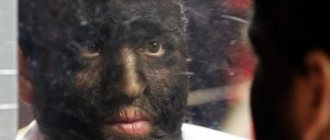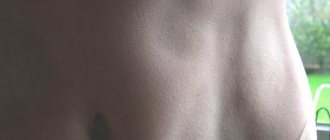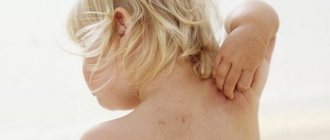What could be the cause of the disease?
- Genetic mutations that cause a structural change in epithelial cells, as a result of which they are transformed into epidermal cells.
- Symptoms can be caused by awakened hair follicles, and this is a real sign of malignant tumors. Often, this disease is precisely a warning about the possibility of oncological processes starting in the future. It has been statistically proven that in 90% of patients with hypertrichosis, tumors are detected after some time.
- Hypertrichosis can also be a side effect from the use of various medications. Such drugs include, for example, streptomycin, penicillin, corticosteroids, psoralen, etc.
- Also, hypertrichosis sometimes signals the presence of skin infectious diseases (for example, dermatomycosis), traumatic brain injuries, and epidermolysis bullosa.
- Anorexia nervosa and exhaustion
- Injuries, hypothermia, and scars cause the formation of local hypertrichosis.
- Regular careless facial depilation, as a result of which previously soft hairs become coarser and darken over time.
- Unhealthy bones (for example, spina bifida)
- Mental disorders (for example, epilepsy)
Causes
1) Genetic
2) Medical conditions
Acquired hypertrichosis is usually present in cancer. This condition is also associated with metabolic disorders such as anorexia, hormone imbalances such as hyperthyroidism, or a side effect of certain medications.
3) Medicines
Several drugs can cause generalized or localized acquired hypertrichosis, including:
- immunosuppressants: cyclosporine;
- vasodilators: diazoxide and minoxidil;
- antibiotics: streptomycin;
- diuretics: acetazolamide.
How does hypertrichosis manifest?
Some differences in symptoms can be found in women and men. In the former, hypertrichosis is characterized by increased hairiness in places where it should not be. This takes into account race and age characteristics. For example, excess hair growth on the legs of Mediterranean women is quite common, but this same manifestation in young Asian women already indicates possible hypertrichosis.
Male hypertrichosis, in the form of abundant hair growth on the back, face or legs, is essentially an atavism that manifests itself already in newborns.
The disease in children is often accompanied by an abundance of birthmarks. Fused eyebrows are also evidence of limited hypertrichosis.
Symptoms
The most common symptom of any type of hypertrichosis is excessive hair growth. There are three types of hair shafts:
1) Lanugo
Refers to long hair. This type of hair is very soft and has no pigment. It doesn't look distinct on the skin. Lanugo is visible on the epidermis of the newborn. This usually goes away on its own over time. However, in the case of hypertrichosis, lanugo does not disappear and requires treatment.
2) Cannon
Unmodulated, soft and slightly pigmented. This type of hair is usually present on the face of a newborn. Hairy hairs have short hair follicles.
3) Terminal hairs
They are formed by follicles and appear very thick. The terminal hairs contain pigment and are therefore dark in color. Hair length may vary depending on the area.
Other symptoms associated with hypertrichosis include:
- Enlarged gums.
- Tooth loss.
- Intelligent latency.
- Epilepsy.
- Visual impairment, problems in the cardiovascular system.
Treatment of hypertrichosis at Es Clinic
The most reliable and best method is hair removal. Moreover, independent hair removal can only lead to progression of the disease. Children's hypertrichosis is eliminated by bleaching or special creams.
Since the main cause of hypertrichosis is a genetic mutation, studying the genome is undoubtedly important. Research and the search for reliable methods of correction will help develop additional treatment methods, which will have a positive impact on the health of future generations.
This information is provided for informational purposes only and should not be used for self-treatment.
Diagnosis and treatment of hypertrichosis
Diagnosis of hypertrichosis includes a complete dermatological and hormonal examination of the patient, since effective treatment of the pathology is impossible without a clearly established root cause.
In addition to consulting a dermatologist and endocrinologist, the woman will need to visit a gynecologist.
The treatment regimen for hypertrichosis is developed individually. If hormonal or other disorders are not detected, then symptomatic treatment (hair removal) is applied.
If one or another pathology is discovered that provokes excess hair growth, then, first of all, treatment is aimed at eliminating it. For example, for polycystic ovary syndrome, hormonal therapy is prescribed. If the cause of hypertrichosis is the use of certain medications, then it is necessary to replace the medication with its analogue.
Often, excess hair growth is not only a cosmetic defect. Hypertrichosis may indicate serious illness. Therefore, if you are concerned about this problem, do not self-medicate - contact SM-Clinic. Doctors will determine the cause of the pathology and draw up a treatment program. Also in our clinic you can take a course of removing excess hair using the latest generation devices.
What treatment measures should be carried out
Any treatment can only take place as prescribed by a doctor. And it will depend directly on the diagnosis. Thus, timely detection and treatment of endocrine disorders most often leads to a positive result, since when the root cause is eliminated, the symptoms go away and hair begins to grow normally. The same applies to telogen effluvium.
In the same case, when we are talking about mechanical damage to the hair, it is enough to loosen the braiding or even abandon it altogether at least for a while and choose more comfortable soft elastic bands - and the problem will be solved by itself.
Ringworm requires a course of treatment with antifungal medications, which most often does not exceed eight weeks. During this period, you need to wash your hair with a special medicated shampoo.
Trichotillomania requires a comprehensive approach. This is the area of competence of psychologists and psychiatrists who conduct conversations with children, specialized training, and also conduct relaxation therapy sessions. There is no “clinic” here when it comes to hair loss in children. As soon as the child stops pulling out hair, hair growth returns to normal.
Complications of hypertrichosis
A timely visit to a doctor will allow you to determine the causes of hypertrichosis in children and select effective treatment. The course of the disease is rarely accompanied by complications. Exceptions include attempts by parents of children to independently remove excess hair.
Damage to mutated tissues under certain circumstances (ecology, diet, heredity) can lead to their degeneration and the appearance of malignant or benign formations on the skin.
We identify risk factors and combat them using adequate methods
A number of factors that can trigger hair loss in young children are similar to those in adults, and some will be specific to a particular age. Let's take a closer look at the main ones.
1) Diseases associated with disorders of the endocrine system , disorders of the liver, adrenal glands or kidneys can, among other symptoms, manifest themselves in hair loss. It should be remembered that while an adult is immediately able to pay attention to changes in health, children, especially young children, can often have difficulty explaining something even to a doctor. Therefore, even if you do not notice any changes in the child’s behavior other than hair loss in children, this is still a reason to consult a pediatrician. Medical and parental attention should be especially close if the child has undergone a course of hormonal treatment.
2) Telogen effluvium is a type of baldness that is especially common in young children. The name of this cause of hair loss in children is taken from the name of the stage of hair growth, namely the period when the hair stops growing for about three months, as if “falling asleep.” This is the final stage of the cycle for one hair. Next comes the repetition of an identical cycle, when new hair replaces the old one. We can talk about telogen effluvium if the hair does not “awaken” in a timely manner. Sometimes, if we are talking about a very young child, this process can improve on its own (but you still need to see a doctor), but more often the condition indicates an excess of vitamin A in the baby’s body.
3) Trauma to the hair shaft is the cause of hair loss in children, which may be due to the effects of exposure to chemicals on the scalp or due to too much mechanical pressure on the hair. This often happens to girls whose parents braid their hair too tightly or use elastic bands and hairpins that damage their hair.
4) Often, children's hair begins to thin and fall out due to a neurotic disorder called trichotillomania. This disease manifests itself in the child’s desire to constantly pull and pull his hair, and quite strongly. If the problem is not identified in a timely manner, it can have far-reaching consequences not only for the baby’s mental health, but also for hair growth itself. With systematic mechanical impact on hair, its growth can slow down and even stop altogether, especially if mini-scars appear as a result of pulling out.
5) Dermatological diseases , in particular ringworm, is another typical “childhood” cause of hair loss in children. The clinical picture in this case is characterized by the presence of first broken hair on the affected area, and then the formation of bald spots, in which inflammation, peeling and severe itching are observed. This disease is a fungal disease, so it should be treated by a dermatologist.
6) Puberty is one of the most difficult periods for a child’s body, when hormonal changes in the entire body take place on “adult lines.” And this can also cause hair loss in teenagers. Increased emotionality often leads to stress, which is known to negatively affect hair follicles.
Hypertrichosis
Hypertrichosis is excessive hair growth that is not typical for a given area of skin, gender and age.
Unlike hirsutism, where hair growth in women follows the male pattern, with hypertrichosis, hair can grow on any part of the skin.
Hypertrichosis is divided into congenital and acquired.
Congenital hypertrichosis:
Congenital lanuginous hypertrichosis.
A very rare disease that causes excess hair growth throughout the body in a newborn baby. Normally, the fetal body is completely covered with unpigmented, fine lanugo hair. The lanugo falls out around the 8th month of gestation and is replaced by vellus hair and terminal hair on the scalp. With congenital hypertrichosis, lanugo hair does not fall out and continues to grow and exist throughout a person’s life.
Congenital terminal hypertrichosis.
This disease is characterized by the growth of terminal, pigmented hair throughout the human body. Almost always combined with gingival hyperplasia (tooth defect). It is this disease that we associate with the image of a werewolf and the “wolf man”.
Nevoid hypertrichosis.
This is an unusual form of hypertrichosis in which hair growth is limited to single foci of terminal hair growth. May appear at birth or later. An example of nevoid hypertrichosis is excessively long hair on the eyebrows.
Nevus-associated hypertrichosis.
Growth of long hair on birthmarks (Becker's nevus, congenital melanocytic nevus, etc.)
Acquired hypertrichosis:
Develops with age and can include both excess growth of vellus and long terminal hair on any area of the face and body.
Reasons for the development of hypertrichosis:
The causes of hypertrichosis are most often unknown. Congenital hypertrichosis is associated with genetic disorders that are hereditary or due to mutations.
Acquired vellus hypertrichosis sometimes occurs in the late stages of internal organ cancer. Thus it is a paraneoplastic symptom. It manifests itself in the growth of fine silky hair on the nose, eyelids and other areas where hair growth is not normally characteristic.
Other possible causes of acquired hypertrichosis:
- metabolic disorders (porphyria)
- medications (oral phenytoin and cyclosporine)
- anorexia nervosa
Local hypertrichosis:
- topical application of medications (iodine, psoralen, minoxidil, steroids)
- area of constant traumatization
- long-term inflammatory skin diseases in this area, infection or vaccination
Treatment of hypertrichosis
If the possible cause cannot be eliminated, then the only treatment option is permanent hair removal. Shaving, waxing, chemical, mechanical depilation. The only method that can help get rid of hair for a very long time is laser hair removal. Laser hair removal for hypertrichosis eliminates long terminal hair, thin pigmented hair, but does not affect completely white, vellus hair.










